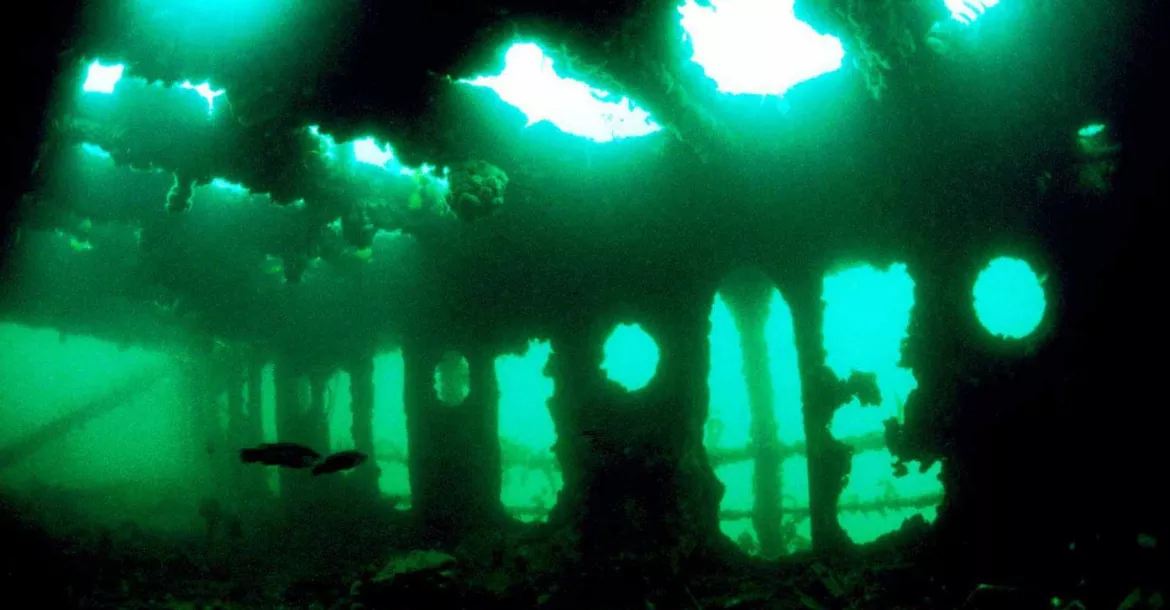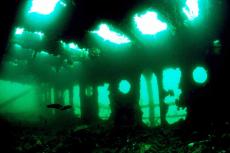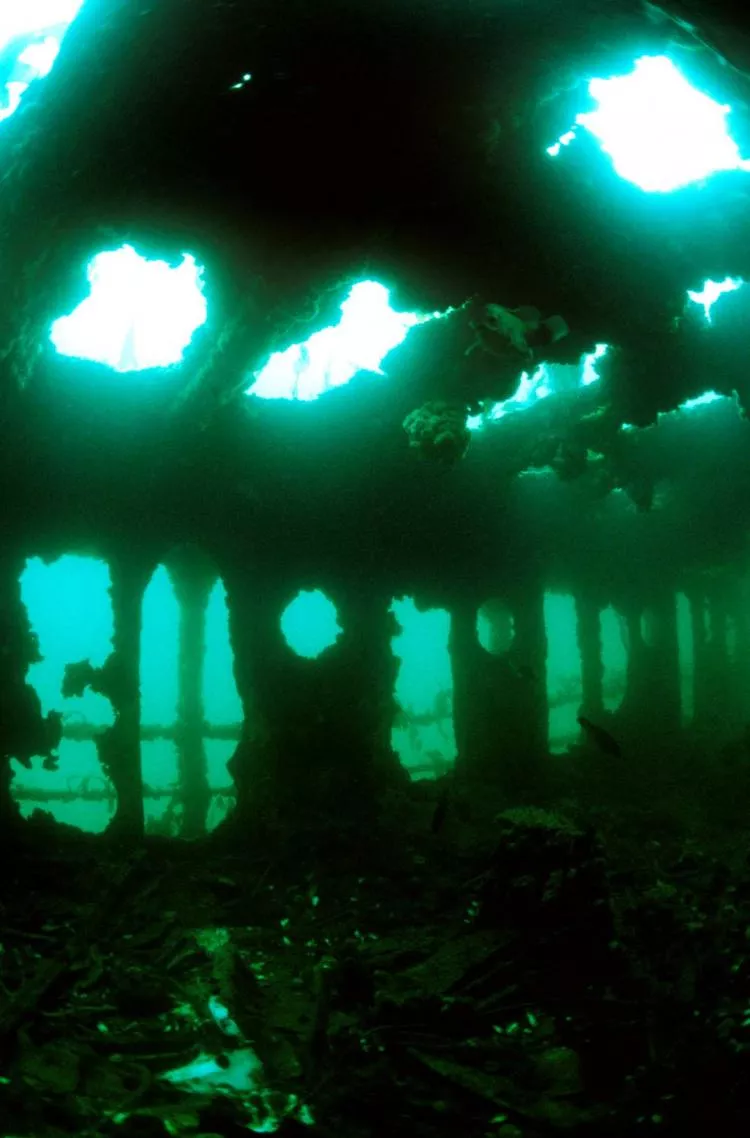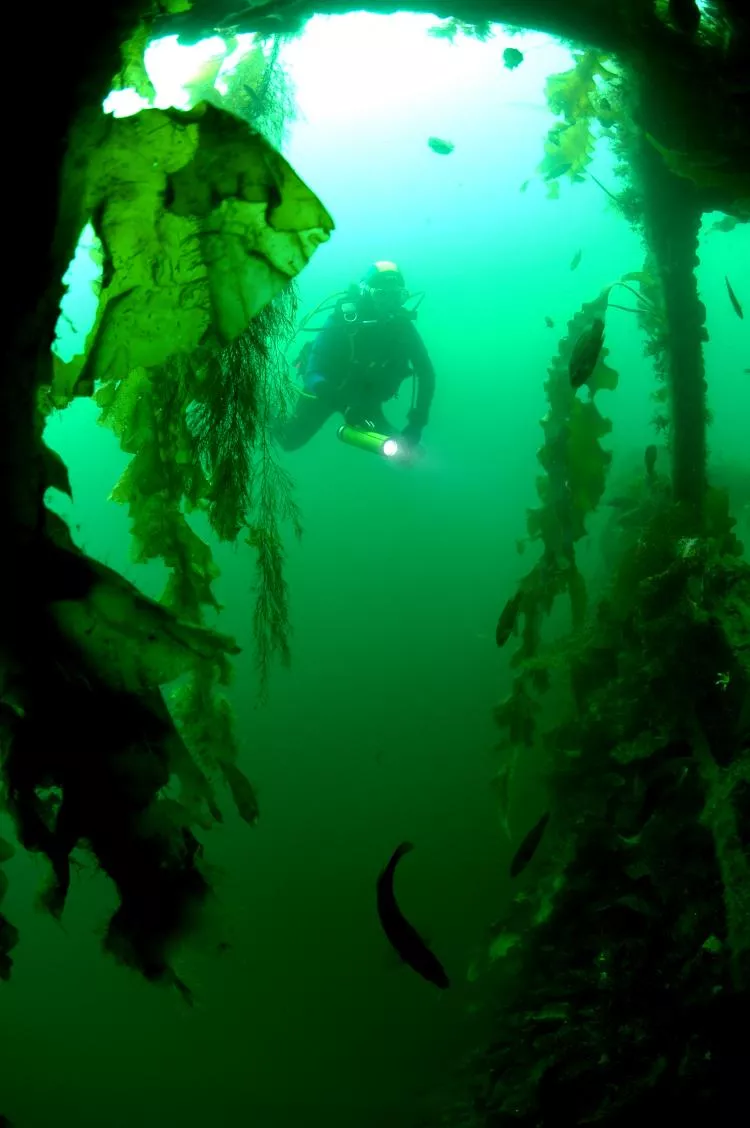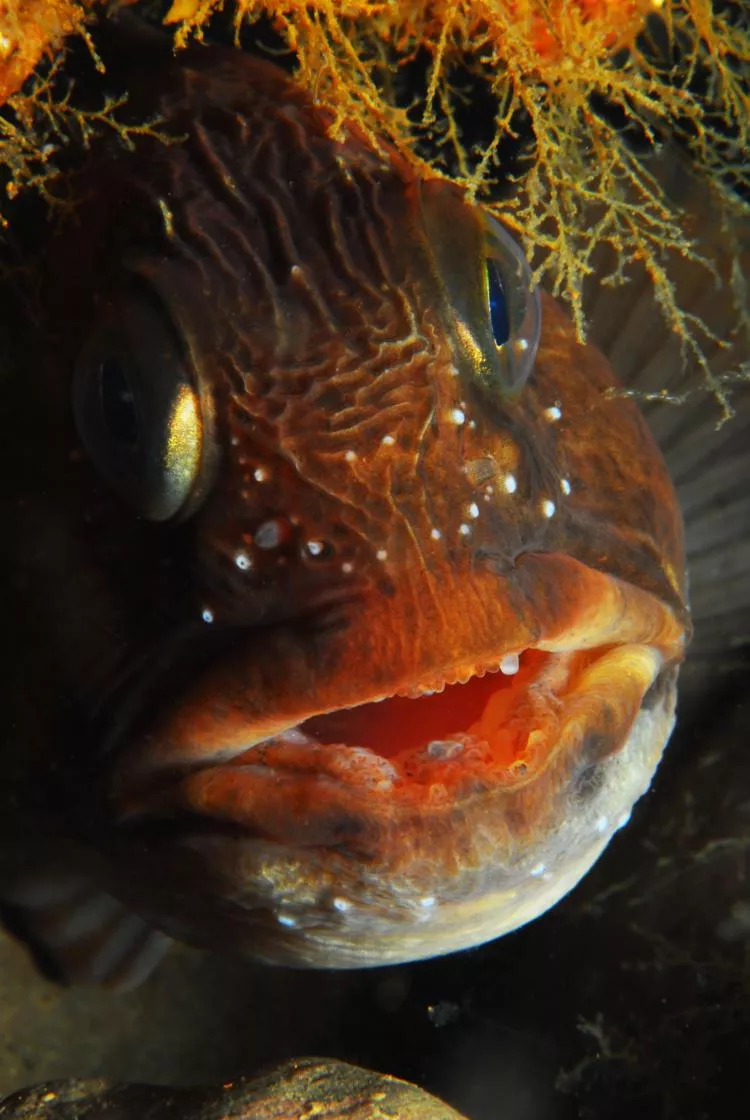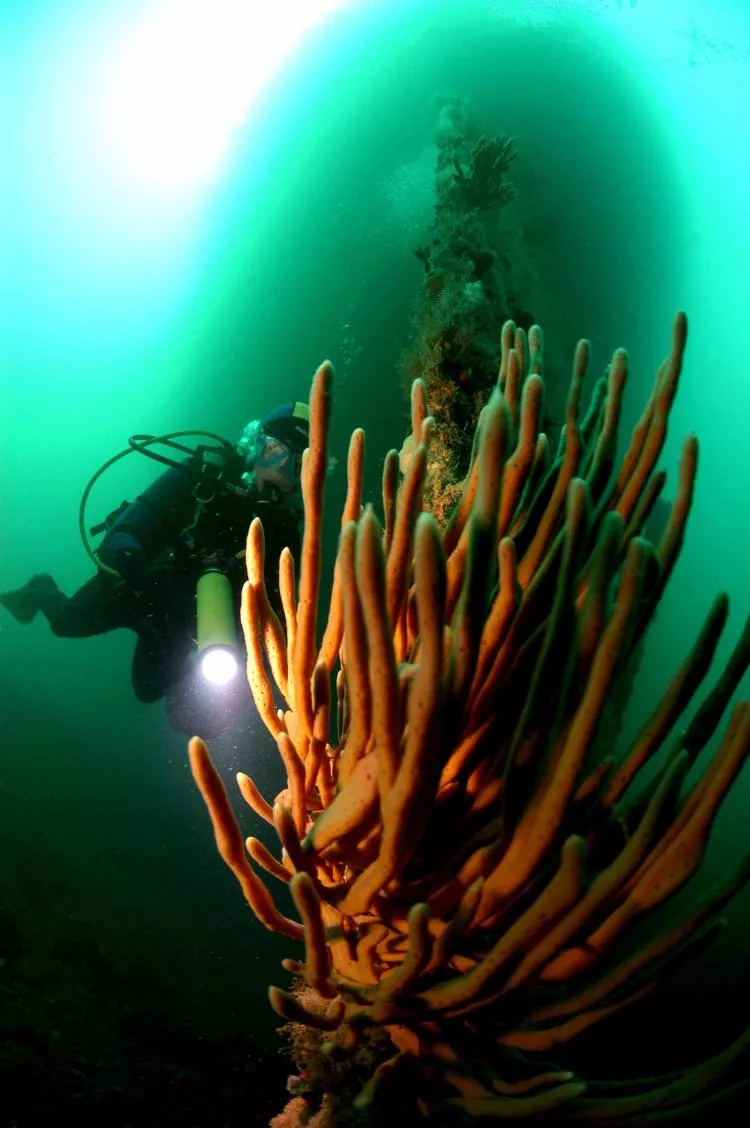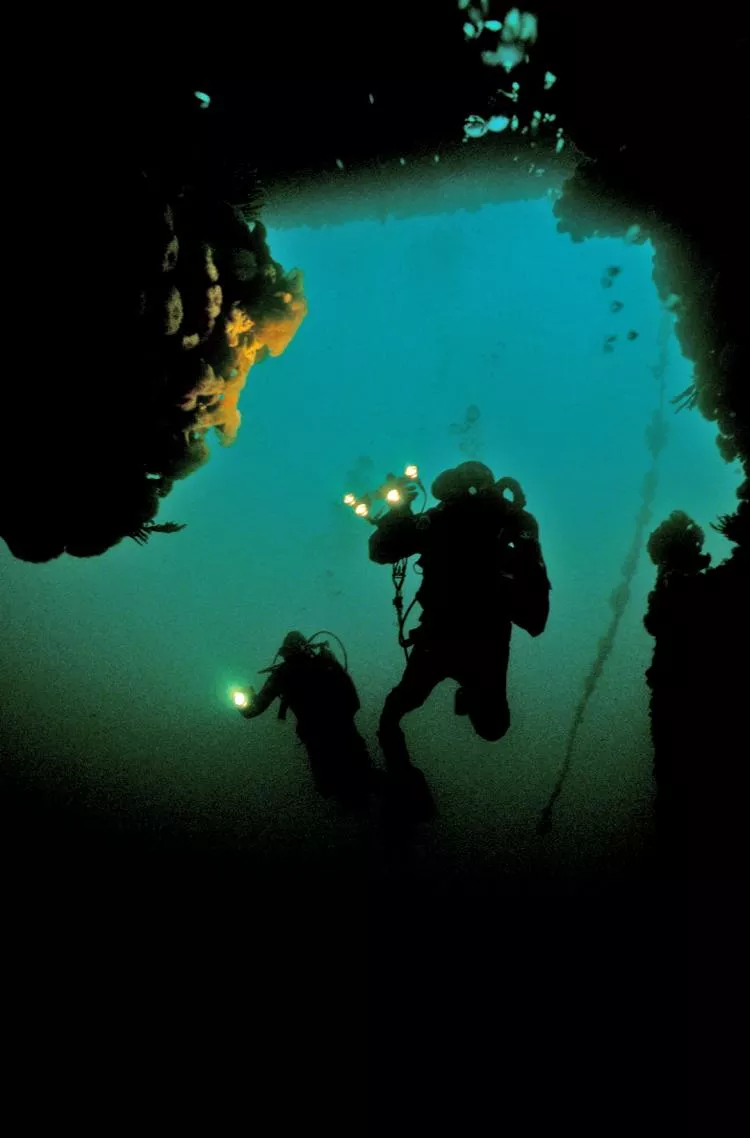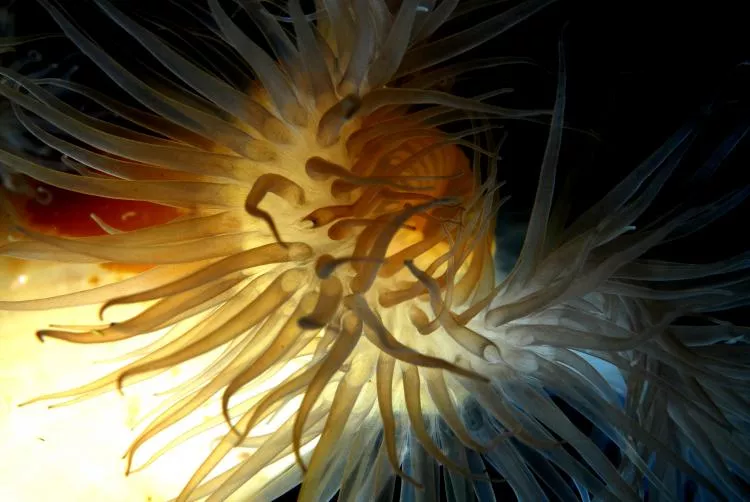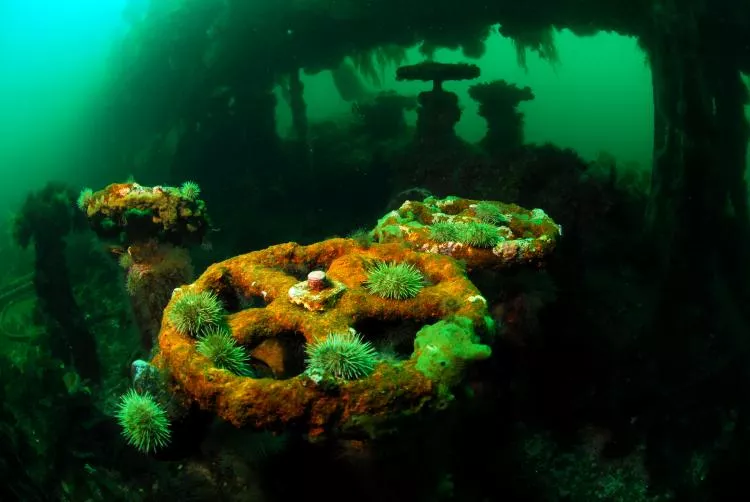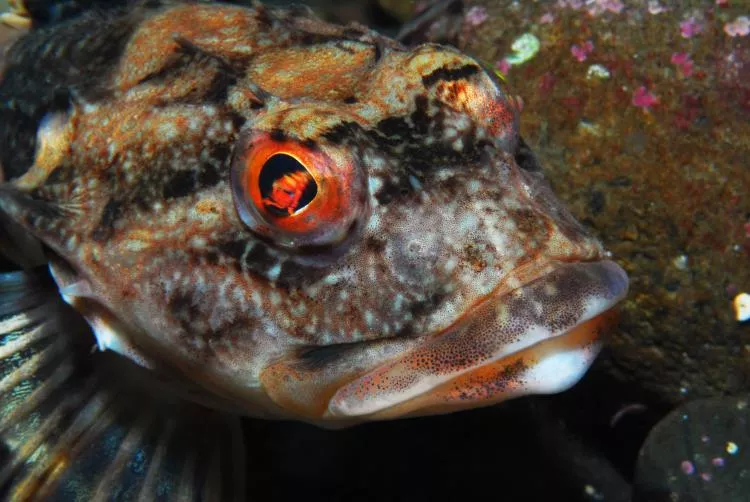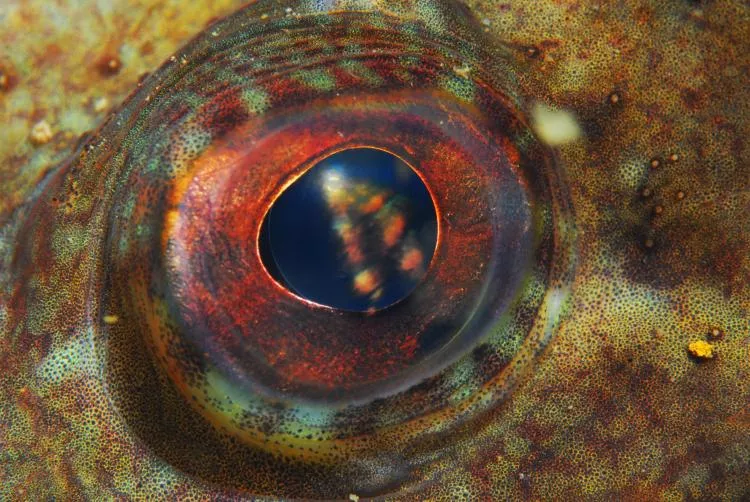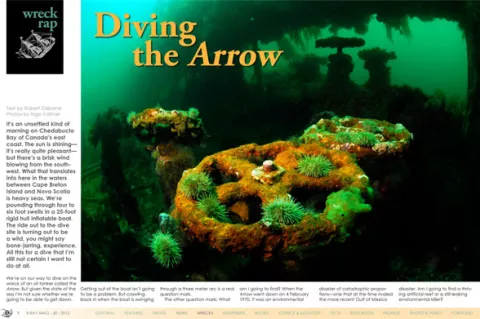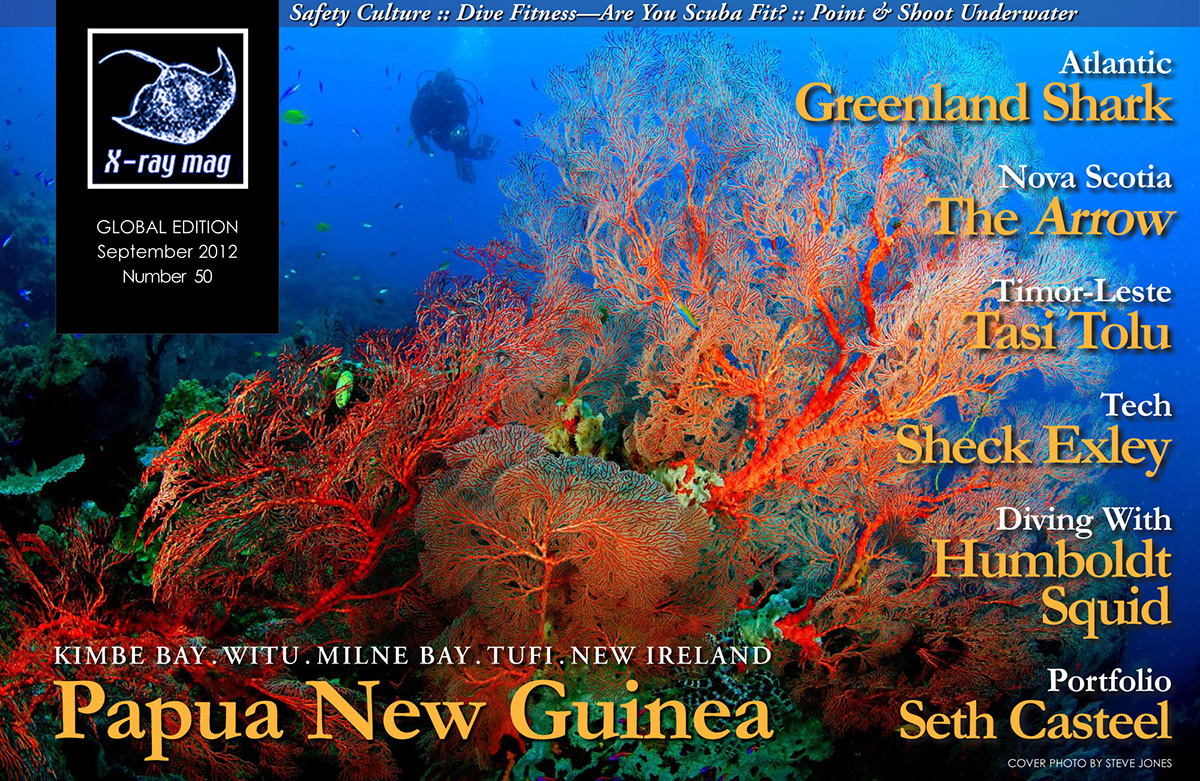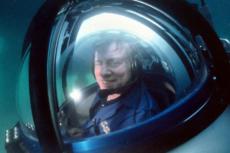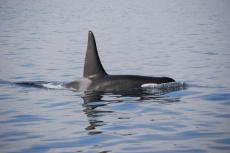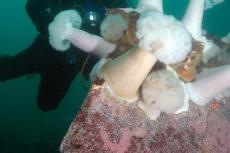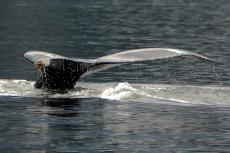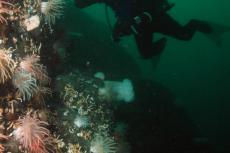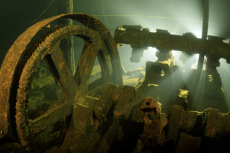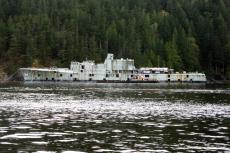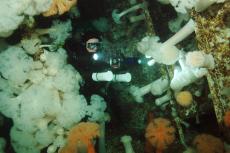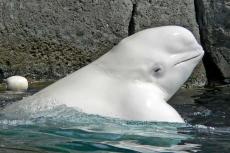It’s an unsettled kind of morning on Chedabucto Bay of Canada’s east coast. The sun is shining—it’s really quite pleasant—but there’s a brisk wind blowing from the southwest. What that translates into here in the waters between Cape Breton Island and Nova Scotia is heavy seas. We’re pounding through four to six foot swells in a 25-foot rigid hull inflatable boat. The ride out to the dive site is turning out to be a wild, you might say bone-jarring, experience. All this for a dive that I’m still not certain I want to do at all.
Contributed by
Factfile
Features editor Robert Osborne is an internationally published dive writer, television producer and reporter based in Toronto, Canada.
The other question mark: What am I going to find? When the Arrow went down on 4 February 1970, it was an environmental disaster of catastrophic proportions—one that at the time rivaled the more recent Gulf of Mexico disaster. Am I going to find a thriving artificial reef or a still leaking environmental killer?
How it happened
The weather was sunny but windy on that winter day when the Olympic Maritime ship Arrow entered Chedabucto Bay. She was hauling 108,000 barrels of Bunker C fuel oil for Imperial Oil, on her way to offload at Nova Scotia Pulp Limited. The Arrow was not what one would describe as the pride of Aristotle Onassis’ fleet. She was 20 years-old—the second oldest ship in the fleet—and the Arrow wasn’t in a great state of repair. In fact, virtually all of her navigation systems, with the exception of her compass, were out of order.
As she entered the bay the Arrow encountered heavy rain and winds gusting to 60 knots.
Slowly but surely, as the ship made its way down the bay she drifted out of the shipping lane. By the time she was way halfway, the Arrow was well out of the safe zone. At 9:30 a.m. she struck Cerberus Rock and ran herself well up onto the reef. Initially officers and crew were not overly concerned. They tried full reverse to get off. No luck. But the captain, George Anastassopoulos, felt that they still could work free at high tide. No distress signal was sent. The first step toward an environmental disaster had just been taken.
Diving the Arrow
After 20 minutes of pounding through the waves we arrive at the buoy that marks the location of the wreck. My host, Ingo Vollmer, casts a skeptical eye on the water conditions. Finally, he makes a decision: “I think it’s possible.” I slide into my dry suit and gear up. My dive buddy for the day is Ingo’s wife, Anita. We roll backwards off the RHIB and swim over to the descent line. A quick check and we submerge. Right away I can tell this isn’t going to be a promising dive. It’s only 30 meters deep here and the rough water has churned up the bottom. We descend to the wreck with only two to three meters of visibility and hit the top of the superstructure at about 20 meters. I can see we’re on a wreck, but not much more.
We’re on our way to dive on the wreck of an oil tanker called the Arrow. But given the state of the sea I’m not sure whether we’re going to be able to get down. Getting out of the boat isn’t going to be a problem. But crawling back in when the boat is swinging through a three meter arc is a real question mark.
Fortunately, Anita knows this dive site like I know my neighborhood; she could find her way around blind folded. She signals me to follow. We manage to complete a circuit of the wreck—down to the rudder at 30 meters and around the hull—but all I can make out are just vague dark impressions. After 30 minutes we give up and head for the surface.
And this is where the dive gets a little tricky. The winds have picked up even more. The RHIB is bouncing up and down in a dangerous manner and there is no dive ladder. Getting back in is like something out of a rodeo. We have to catch hold of a rope and, while hanging on the side, remove our BCDs and weight belts, hand them up to the boat tender and then heave ourselves in. At the top of the arc my feet are nearly clear of the water, at the bottom I’m submerged to my neck. My arm and shoulder get severely yanked around and it takes some real work to hang on, but eventually I manage to get all my gear off and haul myself up over the side. I’m getting too old for this stuff, though I have to admit I feel vaguely like a Navy Seal when it’s all over. Ingo asks me how the dive went. When I tell him, he says: “We’ll try again tomorrow.” He fires up the engines and we head for shore.
History
Hoping tomorrow would bring a better day was something that Captain Anastassopoulos was relying on. He was certain that he could reverse his ship off the rocks. But after trying all day without success he began to realize this was more serious than he’d first thought. The weather was starting to turn really ugly. Finally, he sent out a distress call. A Canadian Fisheries vessel responded and removed most of the crew.
During the next day several attempts were made to tow the Arrow off the rocks. All attempts were unsuccessful. It was finally decided that to pull the ship off the rocks, the oil would have to be pumped out. But salvagers decided to wait until the following day—a decision that some see as the second major error in the catastrophe.
The next morning was too late. When crews arrived on site, a three mile-long oil slick had already spread out across the bay.
Overnight the Arrow had split and the bow section had already sunk spilling 3.5 million gallons of oil. The majority of the ship—the back two-thirds--was still intact on the surface.
Most of the oil was contained in that section. Coast Guard ships tried to get a line on her to tow her into port. But again the weather drove them back.
The following morning the stern section was gone as well. An environmental time bomb was now sitting on the bottom of the bay. Within days, maybe even hours, that bomb could go off releasing millions of gallons of oil.
Back to the present
Day two and we head out once again. Again the winds are coming from the southwest and that means there’s still a heavy swell. As we approach the reef where the Arrow struck, the seas flatten out—marginally. Ingo decides we’re good to go and once again we’re over the side and dropping down the descent line. This time Anita decides we’ll do a circuit around the superstructure and top deck.
Again the visibility is poor. But we’re only at about 20 meters so the light penetration is excellent. I start to see more. Masses of shaggy seaweed cover the gangways of the superstructure. Thousands of small bait fish, a kind of ocean perch called cunners swarm the top of the wreck. As we work our way down the length of the main deck, Anita points out a wonderful macro feature.
The pipes and machinery that used to move the oil are covered in miniature orchid-like sea anemones. As I approach, some of the pipes they look as if they’re covered with frosty clouds of candy floss. We hit the far end of the wreck and I notice a couple of very promising points of penetration—old hatchways that lead down to the forward hold and out the front of the wreck. I make a mental note to revisit them on the next dive when the visibility is better. We hit our turnaround time and head back for the boat.
A more promising dive to be sure, but I can’t help thinking there’s more to this wreck than I’m seeing under these conditions. One thing I am sure of, this wreck is no longer an environmental time bomb.
Response
The first divers visited this wreck within days of her going down, but they weren’t recreational divers. They were military—and with a tough job ahead of them. In response to the sinking, the Canadian government launched what amounted to a virtual military campaign. The spill from the bow section had already contaminated 190 miles of coastline and potentially destroyed the local fishing industry. They didn’t want the rest of that oil leaking out and finishing the job. So the Canadian military, with the assistance of the U.S. and Canadian Coast Guard, started a campaign to save the bay.
It was a two part operation: one part was to clean up and contain the millions of gallons already spilled. The second thrust was to get pumps down to the wreck and get the oil in the stern section safely into a barge. The operation went better than anyone could have expected. Within weeks divers had attached pumps to the outside of the wreck and, using an ingenious technique of pumping hot water into the holds to heat the oil so it would flow, they pumped the oil up to a waiting barge.
The clean up on the shore took a lot longer and the success of that part of the job drew mixed reviews. Eventually, the government declared the operation complete and gradually the disaster drifted from memory.
Faded away until, that is, 20 years later, local divers began to explore the wreck and found that a transformation had taken place. A transformation I’m still trying to see on my third and final day of diving.
Third time's the charm
It begins on a promising note. I poke my head out of my cabin; the sun is shining. What’s even better is that the wind has died completely. I head up to Vollmer Lodge’s dive shop and quickly pack my gear into the RHIB.
This time the journey out is magical. We blast along on a calm sea past islands covered with sea birds. Eagles perch in the trees that line the bay. Every time I turn and look, a harbor seal is poking its head out of the water. Suddenly Chedabucto Bay has come to life.
Without the heavy swell, our trip to wreck takes only a few minutes. We’re over the side in record time and as soon as I submerge I know this dive is going to pay off. I can see the top of the superstructure 20 meters below me. As I descend, I start to get a sense of the scale of the wreck. It’s massive—around 140 meters long, 20 meters wide and about 20 meters high.
We swim past the superstructure and head deeper to do a circuit of the main hull. Swimming ten meters away from the wreck and parallel, I’m dwarfed by the size of the structure. With such great visibility I also start to notice a few other details—the bottom is covered with scallops and lobster.
We circle around to the front of the ship. This is where the bow of the Arrow tore away from the stern; jagged and twisted plates and beams poke out from the hull looking vaguely like some surreal metallic space squid. Oddly there’s enough clearance to swim in for a quick look. A mental note, next time I come I should bring a reel or two, there’s clearly lots to explore inside the hull of the Arrow.
We pop back out and head for the main deck. Now I’m beginning to get a sense of just how alive this artificial reef has become. In the midst of the shaggy masses of seaweed are star fish, crabs, the usual schools of cunners and cod. Little wonder that the harbor seals make this a regular stop for feedings. It’s an underwater smorgasbord.
Hard to imagine what this was like 40 years ago—an environmental disaster of staggering proportions. Later Ingo tells me that inside the hull, you still come across globs of oil, but I see no evidence of any lasting environmental impact on this dive.
Long before I’m ready to surface I’m out of bottom time. This time it’s an easy pull to get into the RHIB and a gentle ride back to shore. I’ve finally seen a good glimpse of the wreck I came to see, the sunken oil tanker I was so curious about.
Research
In fact, the government of Nova Scotia is also curious about what’s going on at the site of the Arrow. It just launched a study to assess the long term effects of the oil spill on the surrounding environment. Researchers may yet discover that what appears to be a thriving ecosystem is still only a thin veneer of life on a toxic sub-surface.
Certainly studies done ten years and even 20 years after the Exxon Valdiz spilled 750,000 barrels of oil into Prince William Sound show that wildlife populations are not recovering quickly and signs of deformities from low levels of toxicity are common.
High levels of leukemia have been recorded and anyone who digs down a few inches discovers globs of oil cropping up. Even in the Bay of Biscayne where the Amaco Cadiz went down in 1978 (spilling 1.6 million barrels of oil) scientists say it could take 60 years before some wildlife populations recover fully.
But if there is any long term damage in and around the wreck of the Arrow, then I’ve certainly not seen anything to indicate this. What I’ve witnessed from my brief visits is an example of how, given time, the sea has an almost infinite capacity to be resilient. ■
Features editor Robert Osborne is an internationally published dive writer, television producer and reporter based in Toronto, Canada.

